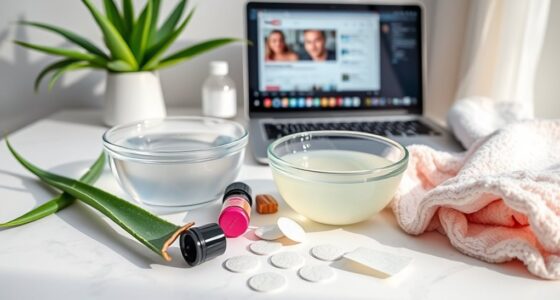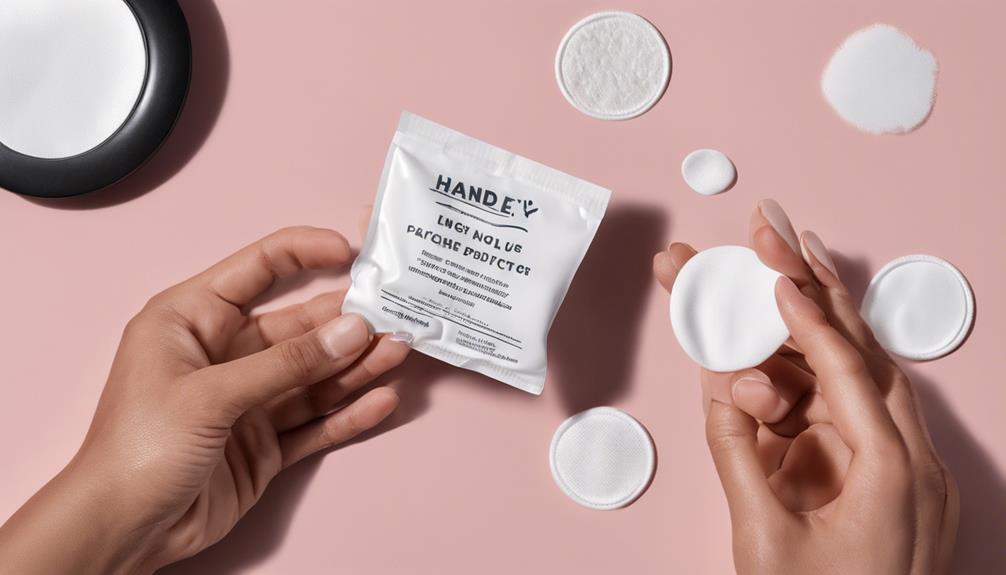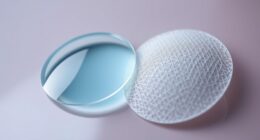You should leave a pimple patch on for 6 to 12 hours for the best results, but if you have a stubborn blemish, it can stay on for up to 24 hours. Just make sure to remove it when it turns white or starts peeling. If you're using patches with active ingredients, you might want to limit the wear time to 4-6 hours. There's more to know about how to maximize patch effectiveness and care for your skin.
Key Takeaways
- Pimple patches should ideally be worn for 6 to 12 hours for best results, but can extend up to 24 hours for stubborn blemishes.
- If the patch turns white or opaque, it's time to remove it or replace it.
- For patches with active ingredients, limit wear time to 4-6 hours for optimal effectiveness.
- Overnight use is recommended as it aligns with the skin's natural repair process.
- Replace patches every 24 hours to avoid bacteria buildup and enhance effectiveness.
Understanding Pimple Patches
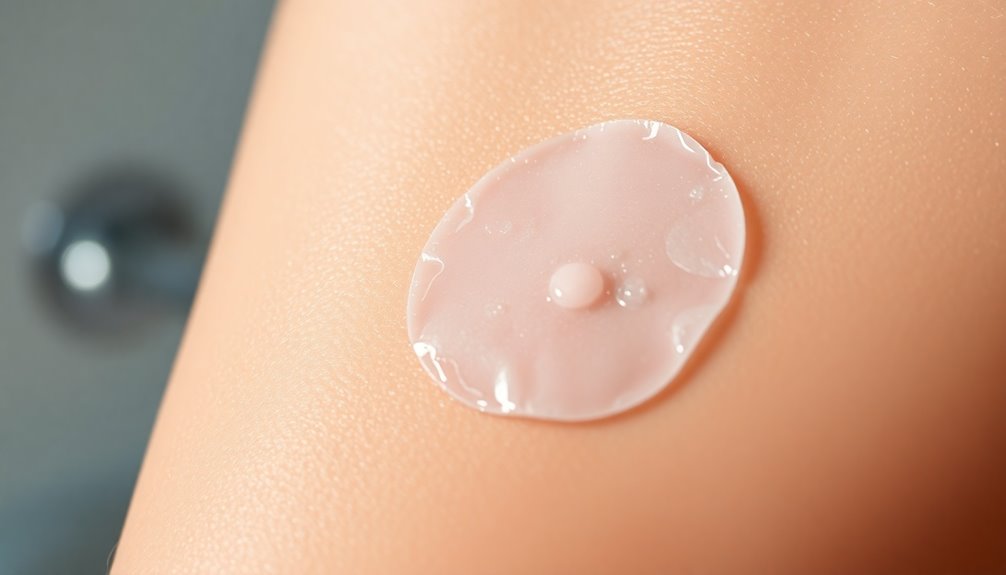
While you might be familiar with various acne treatments, understanding pimple patches can help you decide if they're right for you.
These patches are typically made from hydrocolloid, a gel-like substance that absorbs excess oil and impurities from pimples. You can choose between non-medicated hydrocolloid patches and those infused with salicylic acid or benzoyl peroxide for added benefits. Hydrocolloid patches have been used in medical settings since the late 1960s, showcasing their reliability and effectiveness. Additionally, the nutrient retention in fresh ingredients can enhance your overall skin health, making pimple patches a great addition to your skincare routine.
They create a protective barrier, reducing the risk of picking at your pimples, which minimizes scarring and infection. Suitable for all skin types, including sensitive skin, pimple patches are discreet and easy to use.
They help retain moisture, enhancing your skin's natural healing process while keeping dirt and bacteria at bay.
Recommended Duration for Use
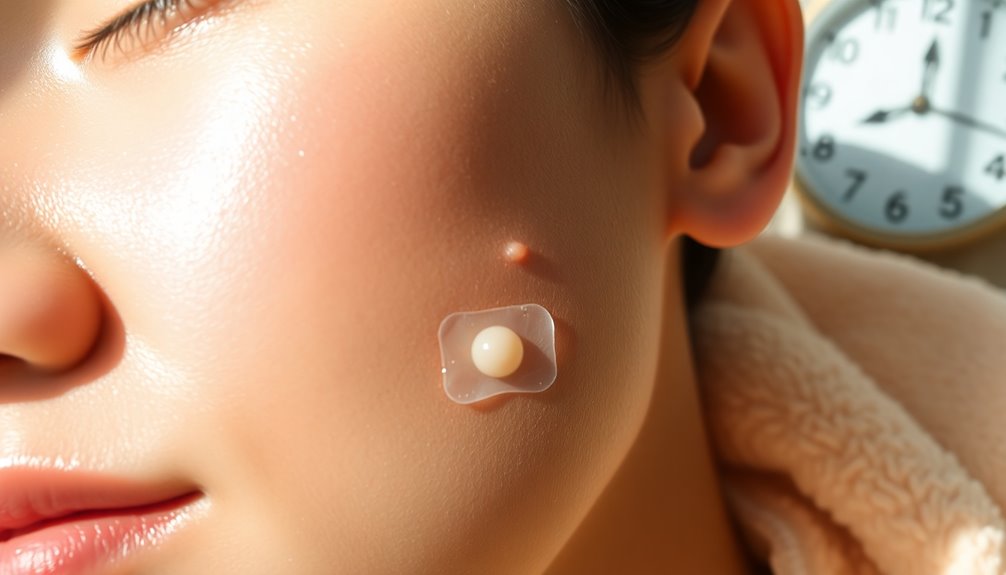
To achieve the best results with pimple patches, it's essential to follow the recommended duration for use. Most hydrocolloid patches work best when left on for 6 to 8 hours, but you can leave them on overnight for 8 to 12 hours for ideal effects. For stubborn blemishes, some patches can be worn for up to 24 hours. This is because hydrocolloid technology creates a protective barrier that helps absorb excess oil and draws out impurities.
For optimal results, wear pimple patches for 6 to 12 hours, and up to 24 hours for persistent blemishes.
Keep these tips in mind:
- Remove patches when they turn white or opaque.
- Replace patches if they start to peel off.
- Active ingredient patches may require shorter wear times (4-6 hours).
- Be mindful of skin sensitivity; use patches for shorter durations if needed.
- Overnight use can align with your skin's natural repair process.
Factors Influencing Effectiveness

When considering the effectiveness of pimple patches, several factors come into play that can considerably influence your results.
Your skin type matters; oily skin may hinder adhesion, while dry skin benefits from moisture retention. For sensitive skin, shorter wear times help avoid irritation. Properly prepping your skin enhances patch adhesion, too. The hydrocolloid patch's ability to create a moist environment promotes healing, making it particularly beneficial for open pimples. Additionally, the use of patches designed for cystic acne treatment can significantly improve the effectiveness of the healing process.
The active ingredients in the patches, like tea tree oil and salicylic acid, also play a key role in combating acne.
Environmental factors, including pollution and friction, can exacerbate breakouts, but patches protect against these irritants.
Finally, the physical properties of the patches—size, transparency, and thickness—affect comfort and absorption.
Different Types of Acne

When dealing with different types of acne, you'll notice that not all breakouts respond the same to pimple patches. For instance, while whiteheads can benefit from patches, blackheads might show limited effectiveness. Cystic acne, on the other hand, often requires more intensive treatment options due to its severity. Cystic acne is a severe form of acne characterized by large, inflamed, and painful cysts that develop deep under the skin. Using hydrocolloid technology in your acne patches can help promote healing by drawing out impurities effectively.
Whiteheads and Pimple Patches
While whiteheads can be frustrating, using pimple patches can effectively manage them. These patches absorb excess fluid and oil, flattening whiteheads while creating a protective barrier against bacteria. They also keep the area moist, promoting faster healing and maintaining a moist environment to minimize scarring.
Here are some benefits of using pimple patches for whiteheads:
- Absorbs pus and oil for quicker results.
- Reduces inflammation and redness.
- Prevents picking, minimizing infection risk.
- Compatible with all skin types, including sensitive skin.
- Available with active ingredients like tea tree oil and salicylic acid.
For the best results, leave the patch on for 6 to 8 hours, preferably overnight, to maximize its effectiveness.
This simple step can lead to clearer skin and a more confident you!
Blackheads: Limited Effectiveness
Although pimple patches are a popular choice for treating various types of acne, their effectiveness on blackheads is limited. Hydrocolloid patches don't directly pull out blackheads like pore strips do. While they can help reduce excess sebum, which may minimize the appearance of blackheads, they aren't a long-term solution. Reducing sebum can help prevent clogged pores, which may lead to fewer blackheads over time. Chia seeds, known for their high fiber content, may also aid in maintaining skin health by promoting digestion and reducing inflammation.
If you're dealing with blackheads, consider salicylic acid patches, as they offer exfoliating properties that might be more beneficial. Remember, patches don't prevent future blackhead formation.
For the best results, incorporate a consistent skincare routine with chemical exfoliants or clay masks, and consider professional treatments for severe cases. Ultimately, your skin type and the severity of your blackheads will influence how effective these patches are for you.
Cystic Acne Considerations
Cystic acne stands out among different types of acne due to its severity and the deep, painful cysts it creates beneath the skin. You might find these breakouts are more common during hormonal changes, affecting both teens and adults.
Here are some key considerations:
- Definition: Large, pus-filled cysts forming deep in the skin.
- Causes: Bacteria, oil, and dead skin cells clogging pores.
- Risk Factors: Hormonal imbalances, particularly in women.
- Symptoms: Painful, itchy, and red breakouts.
- Complications: Risk of permanent scarring if untreated. Cystic acne is the most serious type of acne and often requires prescription medications for effective treatment.
Pimple patches may not effectively treat cystic acne, so consulting a dermatologist for tailored treatments is essential. Consider oral medications or topical treatments for better results.
Best Practices for Application
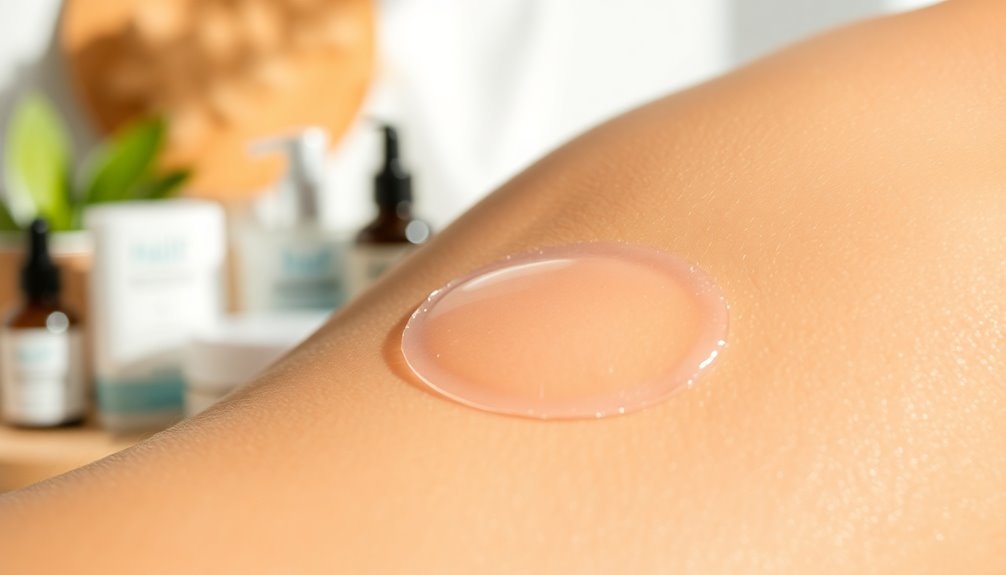
To achieve the best results when applying a pimple patch, start with a thorough skin cleansing routine. Remove all dirt, sebum, and bacteria to create a clean canvas. Make certain your skin is completely dry to enhance adhesion. Pimple patches work by attracting pimple fluid to the surface of the skin using hydrocolloid, which helps speed up the healing process.
Choose a patch that fully covers the pimple for maximum effectiveness, and avoid layering products under the patch, as this can hinder its performance. Always wash your hands beforehand to prevent contamination.
When applying, place the patch directly over the pimple, pressing lightly for a secure fit. Confirm patches don't overlap to avoid irritation.
Finally, check that the patch adheres well to your skin, adjusting based on your skin type if necessary for the best results.
Signs It's Time to Replace the Patch
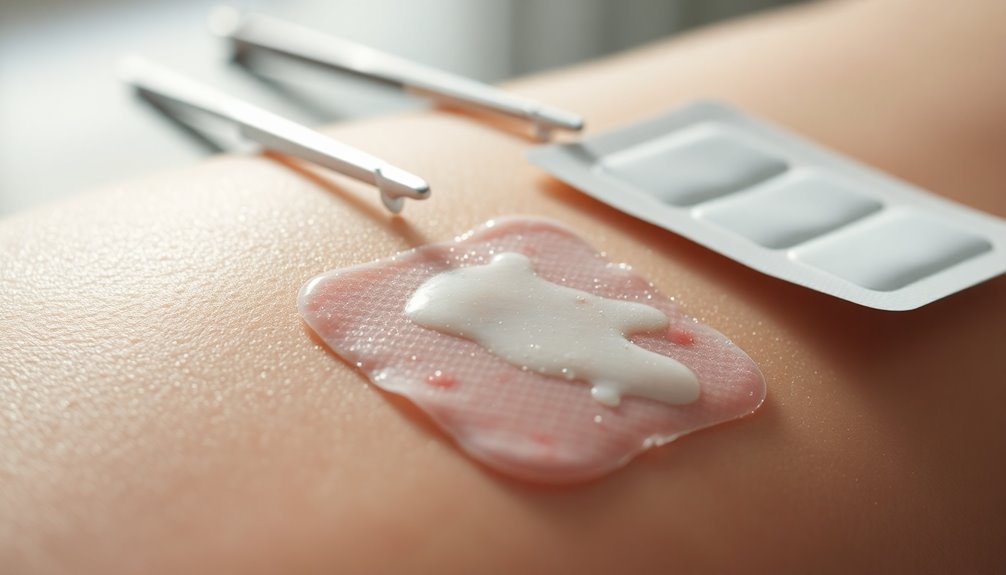
You should keep an eye on your pimple patch for a few key signs that it needs replacing.
If it feels uncomfortable, shows signs of saturation, or the recommended time has passed, it's time to swap it out. Pimple patches are most effective on whiteheads, so recognizing these indicators can help guarantee your skin heals effectively.
Patch Saturation Indicators
Recognizing when a pimple patch needs replacing is essential for maintaining skin health and effectiveness. Keep an eye out for these saturation indicators:
- Visual Changes: If your patch turns opaque or white, it's saturated.
- Adhesive Breakdown: A patch that starts peeling off has lost adhesion.
- Swelling or Lifting: If the edges lift or the patch swells, it's time for a change.
- Duration Guidelines: Patches generally work best for 4-8 hours, but can last up to 24 hours. Additionally, hydrocolloid dressings are designed to absorb impurities and create a moist environment for faster healing.
- Hygiene Considerations: Replacing patches every 24 hours helps prevent bacteria buildup.
Skin Discomfort or Irritation
While using pimple patches can be effective, it's vital to stay alert for signs of skin discomfort or irritation that signal it's time to replace them.
Look out for increased redness, itching, or peeling around the patch area, as these indicate irritation. If you notice swelling or experience persistent discomfort, it's best to remove the patch. Contact dermatitis can develop from the adhesive or ingredients in the patch, so be cautious if you notice any adverse reactions.
Some people may react sensitively to the adhesive or active ingredients, especially if they've sensitive skin. If any of these signs appear, don't hesitate to take the patch off.
Time Elapsed Since Application
Knowing when to replace a pimple patch is essential for maximizing its effectiveness and ensuring skin health.
Here are some signs that it's time to swap out your patch:
- Color Change: If the patch turns white or cloudy, it's absorbed impurities.
- Loss of Adhesion: A patch that starts to peel off isn't effective anymore.
- Time Limit Reached: Remove patches after the recommended time to avoid irritation.
- Pimple Improvement: Once the pimple flattens and redness decreases, it's time to remove it. Hydrocolloid patches are designed to be worn for several hours, commonly overnight.
- Patch Saturation: If it becomes fully saturated, replace it for best results.
Combining Pimple Patches With Other Treatments

Combining pimple patches with other treatments can enhance your acne-fighting routine, as these patches work effectively alongside various topical products. You can pair them with salicylic acid or benzoyl peroxide to target acne more aggressively. Some patches are infused with beneficial ingredients like niacinamide or tea tree oil, which help reduce inflammation. Pimple patches create a moist environment that helps draw out impurities, making them a great addition to any acne treatment regimen.
Here's a quick guide on popular combinations:
| Treatment Type | Benefits |
|---|---|
| Salicylic Acid | Exfoliates and unclogs pores |
| Tea Tree Oil | Offers antibacterial properties |
| Niacinamide | Improves skin elasticity and reduces redness |
| Blue Light Therapy | Targets acne-causing bacteria post-removal |
Always monitor your skin response and consult a dermatologist for personalized advice on combining treatments.
Clinical Evidence Supporting Pimple Patch Use
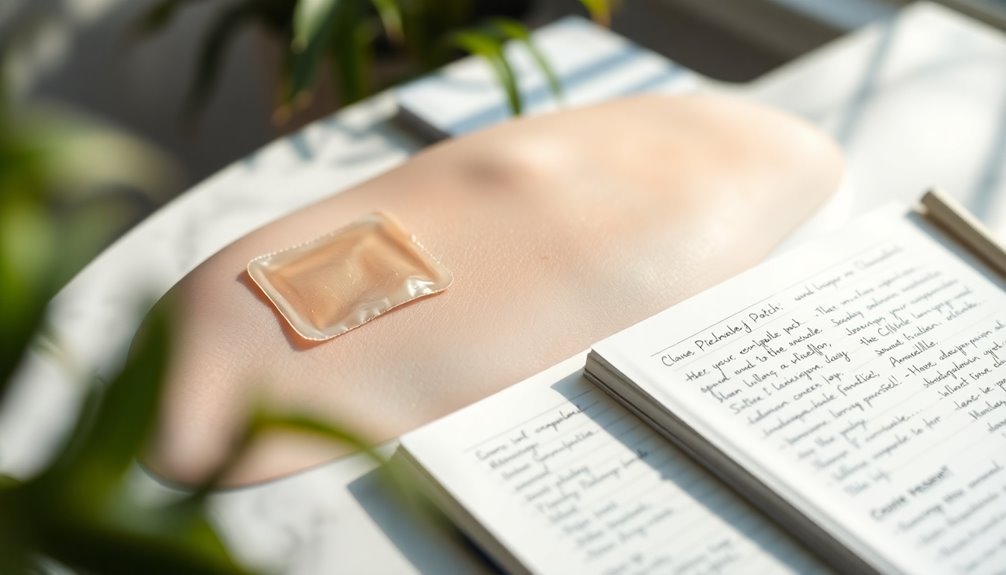
As you seek effective solutions for acne, it's important to evaluate the clinical evidence supporting pimple patch use. Research shows hydrocolloid patches are particularly effective in reducing acne severity and inflammation.
Here are some key findings:
- Hydrocolloid patches outperform non-hydrocolloid options in controlling redness and oiliness.
- They absorb impurities, promoting faster healing. Hydrocolloid acne pads are known to keep the area clean and prevent further irritation.
- Studies indicate these patches work well for mild to moderate acne.
- Their safety profile is strong, with minimal reported side effects.
- While beneficial for surface pimples, they're less effective for deeper acne.
Frequently Asked Questions
Can Pimple Patches Be Reused After Washing?
You shouldn't reuse pimple patches, even after washing.
When you use a patch, it absorbs oils and impurities from your skin, making it unsanitary to apply it again. Reusing can lead to bacteria buildup and skin irritation.
Plus, the patch's adhesion may weaken, reducing its effectiveness.
It's best to stick with single-use patches for ideal results and to maintain your skin's health.
Always prioritize hygiene when dealing with breakouts!
Are There Any Skin Types That Should Avoid Pimple Patches?
If you have sensitive skin or allergies to adhesives, you might want to avoid pimple patches. They can cause irritation, redness, or burning for those with easily reactive skin.
Additionally, if you're allergic to ingredients like salicylic acid, steer clear of patches containing them. Always test a small area first to see how your skin reacts, and consider consulting a dermatologist if you're unsure about using them on your skin type.
Do Pimple Patches Work on All Skin Tones?
Yes, pimple patches work on all skin tones!
They're designed to be transparent or lightly tinted, allowing your natural skin tone to shine through. This means you can wear them comfortably without worrying about visibility, even on darker skin.
The hydrocolloid material helps absorb impurities and creates a moist environment for healing, making them effective for surface-level acne.
Plus, you'll benefit from extra protection against irritants while reducing inflammation.
Can I Apply Makeup Over a Pimple Patch?
Yes, you can apply makeup over a pimple patch without affecting its effectiveness.
Just be gentle when applying to avoid dislodging it. Use a light touch and opt for a matte finish to help it blend seamlessly with your skin.
Try using a matte concealer that matches your skin tone or one that corrects the patch's color.
How Do I Know if a Pimple Patch Is Working?
You can tell if a pimple patch is working by observing changes in your pimple. If you notice reduced redness and swelling, that's a good sign.
Check for a decrease in size over time, too. When the patch turns white or opaque, it's absorbed impurities and may need replacing.
Keep in mind that effectiveness can vary based on your skin type and the specific acne being treated. Always be patient and give it some time.
Conclusion
In the battle against blemishes, pimple patches can be your secret weapon. By following the recommended duration and best practices for application, you'll maximize their effectiveness. Remember, it's essential to pay attention to your skin's needs and replace the patch when necessary. Combining them with other treatments can also yield better results. So, don't throw caution to the wind; take care of your skin, and you'll soon see those pesky pimples fade away.




